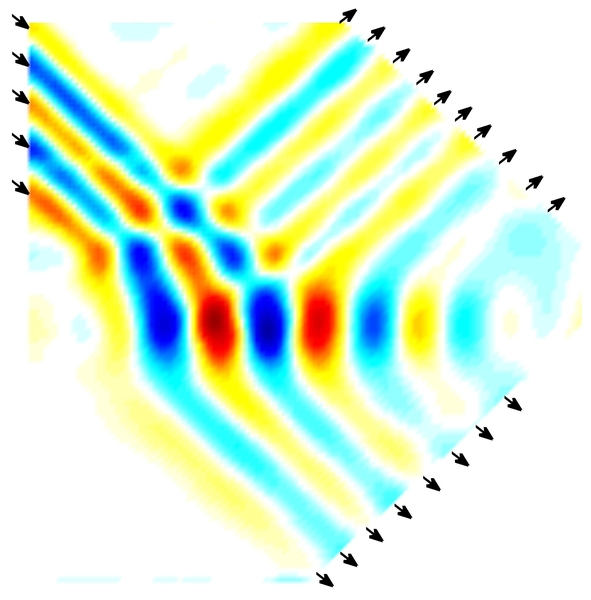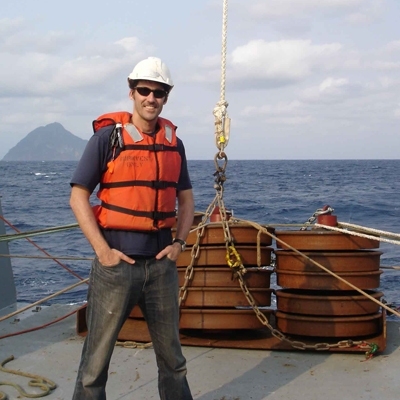Internal waves — huge but nearly invisible ripples that occur in the oceans, the atmosphere and stars — can play an important role in climate change and other processes, but there is plenty about them that remains to be understood. In a significant new finding, however, MIT researchers have discovered that some important aspects of these waves can be analyzed using the same techniques physicists have developed to study the passage of light.
“There’s a direct mathematical connection between how these waves travel in the ocean and the atmosphere, and the classical properties of an optical interferometer,” says Associate Professor of Mechanical Engineering Thomas Peacock. Optical interferometers use a pair of partially reflecting parallel mirrors to selectively block or transmit specific wavelengths of light, a technique widely used in fiber-optic communications systems, lasers and astronomical instruments. The method works because the beam of light is reflected back and forth between the two mirrors, and depending on the precise spacing between the mirrors the light beams that emerge at the other side will either reinforce each other (if the peaks of the waves match up) or weaken each other (if the peak of one wave lines up with the trough of another).
Because the optical method is well studied and understood, this new insight should make it easier for researchers to probe the mysteries of internal waves in the air and sea. It also could enhance the accuracy of global climate models by helping scientists understand where the energy and momentum carried by such waves is deposited in the oceans.
The new findings are described in a paper published recently in Physical Review Letters, written by Peacock and mechanical engineering doctoral student Manikandan Mathur. The research was funded by the NSF and the Office of Naval Research.
Layer by layer
Internal waves behave similarly to the waves on the surface of a body of water, but consist of the movement of regions within the water (or air) that have relatively different densities because of variations in temperature or composition (such as the amount of dissolved salt). Such waves can be very large, with heights of up to 100 meters and widths of hundreds of miles. In the ocean, such waves are usually generated when tides cause water to move over submerged mountains on the ocean floor; in the air, they are produced when wind blows over mountain ranges, or are triggered by large thunderstorms.
Internal waves play an important role in mixing the different layers of water in the oceans, which in turn affects climate. The rate of such mixing remains one of the greatest areas of uncertainty in present climate models.
The oceans are vertically stratified — that is, there is an increasing density with depth — because colder water and saltier water are heavier and so tend to sink. The boundaries between these layers of water with different strength of stratification, like the boundaries between two different kinds of glass, can cause waves propagating through them to bend.
The key insight described in this research is that pairs of these boundaries behave like giant interferometers: When encountering boundaries between layers that have different density gradients, internal waves undergo the same kinds of reflections and strengthening or weakening effects as light waves in an optical interferometer. As a result, these layers selectively transmit or block waves of specific wavelengths.
Peacock and Mathur calculated exactly how these interactions should work, based on classical optical theory, and then confirmed experimentally that this is indeed what happens by building an internal wave interferometer.
To do that, they performed tests in a wave tank that was carefully prepared using salt-stratified water, in which they generated waves of precisely controlled wavelengths. They suspended microscopic glass beads in the water, which reflected beams of laser light they shone through the tank. This allowed the researchers to detect the movements of the invisible waves within the water, and it showed that the semi-reflective layers do indeed filter out specific wavelengths of the waves — just as in optics such mirrors can selectively allow passage of only certain colors.
A link to light
This connection between the behavior of internal waves and the behavior of light had not previously been demonstrated, Mathur says. Now that they have shown the relationship, “it’s possible there are more connections between optics and internal waves. There may be other techniques already established in optics that we may be able to use to study internal waves.”
Earlier work by Peacock and his students revealed details of how the waves are generated, but the new work provides significant new information about how they propagate through the oceans and the atmosphere. And although Peacock and his students did not specifically study such processes in their tests, the work could also help astrophysicists understand related processes in the interiors of stars.
Thierry Dauxois, director of research at France’s National Center for Scientific Research (CNRS) in Lyon, says this work is significant both as an advance in basic scientific understanding, and for its practical implications in understanding global heat-distribution mechanisms. “The interferometry might have an effect in real systems, with possible geophysical applications in the ocean or in the atmosphere, and even possibly in stars where internal waves do exist,” he says. “Working on both aspects, fundamental physics and applications, is I think very appealing.”
Dauxois, who was not involved in this research, adds that there is a crucial remaining question to be solved: “How these internal waves dissipate is a key question, largely open nowadays, and extremely important.”
Peacock says he is working on addressing that problem as part of his ongoing research. For now, he says, the next step is to use the analytical methods developed in this research to make more specific predictions about particular regions of the ocean, and ultimately test those predictions in the field.
“There’s a direct mathematical connection between how these waves travel in the ocean and the atmosphere, and the classical properties of an optical interferometer,” says Associate Professor of Mechanical Engineering Thomas Peacock. Optical interferometers use a pair of partially reflecting parallel mirrors to selectively block or transmit specific wavelengths of light, a technique widely used in fiber-optic communications systems, lasers and astronomical instruments. The method works because the beam of light is reflected back and forth between the two mirrors, and depending on the precise spacing between the mirrors the light beams that emerge at the other side will either reinforce each other (if the peaks of the waves match up) or weaken each other (if the peak of one wave lines up with the trough of another).
Because the optical method is well studied and understood, this new insight should make it easier for researchers to probe the mysteries of internal waves in the air and sea. It also could enhance the accuracy of global climate models by helping scientists understand where the energy and momentum carried by such waves is deposited in the oceans.
The new findings are described in a paper published recently in Physical Review Letters, written by Peacock and mechanical engineering doctoral student Manikandan Mathur. The research was funded by the NSF and the Office of Naval Research.
Layer by layer
Internal waves behave similarly to the waves on the surface of a body of water, but consist of the movement of regions within the water (or air) that have relatively different densities because of variations in temperature or composition (such as the amount of dissolved salt). Such waves can be very large, with heights of up to 100 meters and widths of hundreds of miles. In the ocean, such waves are usually generated when tides cause water to move over submerged mountains on the ocean floor; in the air, they are produced when wind blows over mountain ranges, or are triggered by large thunderstorms.
Internal waves play an important role in mixing the different layers of water in the oceans, which in turn affects climate. The rate of such mixing remains one of the greatest areas of uncertainty in present climate models.
The oceans are vertically stratified — that is, there is an increasing density with depth — because colder water and saltier water are heavier and so tend to sink. The boundaries between these layers of water with different strength of stratification, like the boundaries between two different kinds of glass, can cause waves propagating through them to bend.
The key insight described in this research is that pairs of these boundaries behave like giant interferometers: When encountering boundaries between layers that have different density gradients, internal waves undergo the same kinds of reflections and strengthening or weakening effects as light waves in an optical interferometer. As a result, these layers selectively transmit or block waves of specific wavelengths.
Peacock and Mathur calculated exactly how these interactions should work, based on classical optical theory, and then confirmed experimentally that this is indeed what happens by building an internal wave interferometer.
To do that, they performed tests in a wave tank that was carefully prepared using salt-stratified water, in which they generated waves of precisely controlled wavelengths. They suspended microscopic glass beads in the water, which reflected beams of laser light they shone through the tank. This allowed the researchers to detect the movements of the invisible waves within the water, and it showed that the semi-reflective layers do indeed filter out specific wavelengths of the waves — just as in optics such mirrors can selectively allow passage of only certain colors.
A link to light
This connection between the behavior of internal waves and the behavior of light had not previously been demonstrated, Mathur says. Now that they have shown the relationship, “it’s possible there are more connections between optics and internal waves. There may be other techniques already established in optics that we may be able to use to study internal waves.”
Earlier work by Peacock and his students revealed details of how the waves are generated, but the new work provides significant new information about how they propagate through the oceans and the atmosphere. And although Peacock and his students did not specifically study such processes in their tests, the work could also help astrophysicists understand related processes in the interiors of stars.
Thierry Dauxois, director of research at France’s National Center for Scientific Research (CNRS) in Lyon, says this work is significant both as an advance in basic scientific understanding, and for its practical implications in understanding global heat-distribution mechanisms. “The interferometry might have an effect in real systems, with possible geophysical applications in the ocean or in the atmosphere, and even possibly in stars where internal waves do exist,” he says. “Working on both aspects, fundamental physics and applications, is I think very appealing.”
Dauxois, who was not involved in this research, adds that there is a crucial remaining question to be solved: “How these internal waves dissipate is a key question, largely open nowadays, and extremely important.”
Peacock says he is working on addressing that problem as part of his ongoing research. For now, he says, the next step is to use the analytical methods developed in this research to make more specific predictions about particular regions of the ocean, and ultimately test those predictions in the field.








